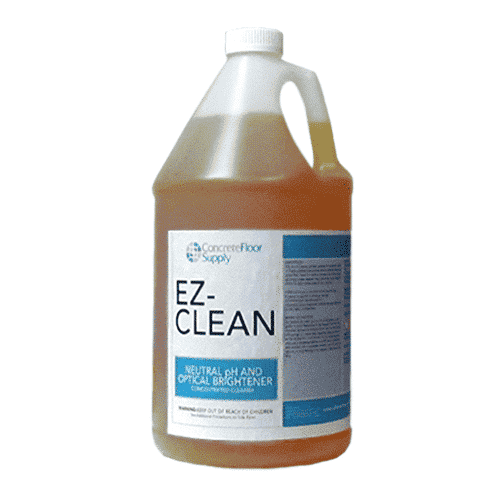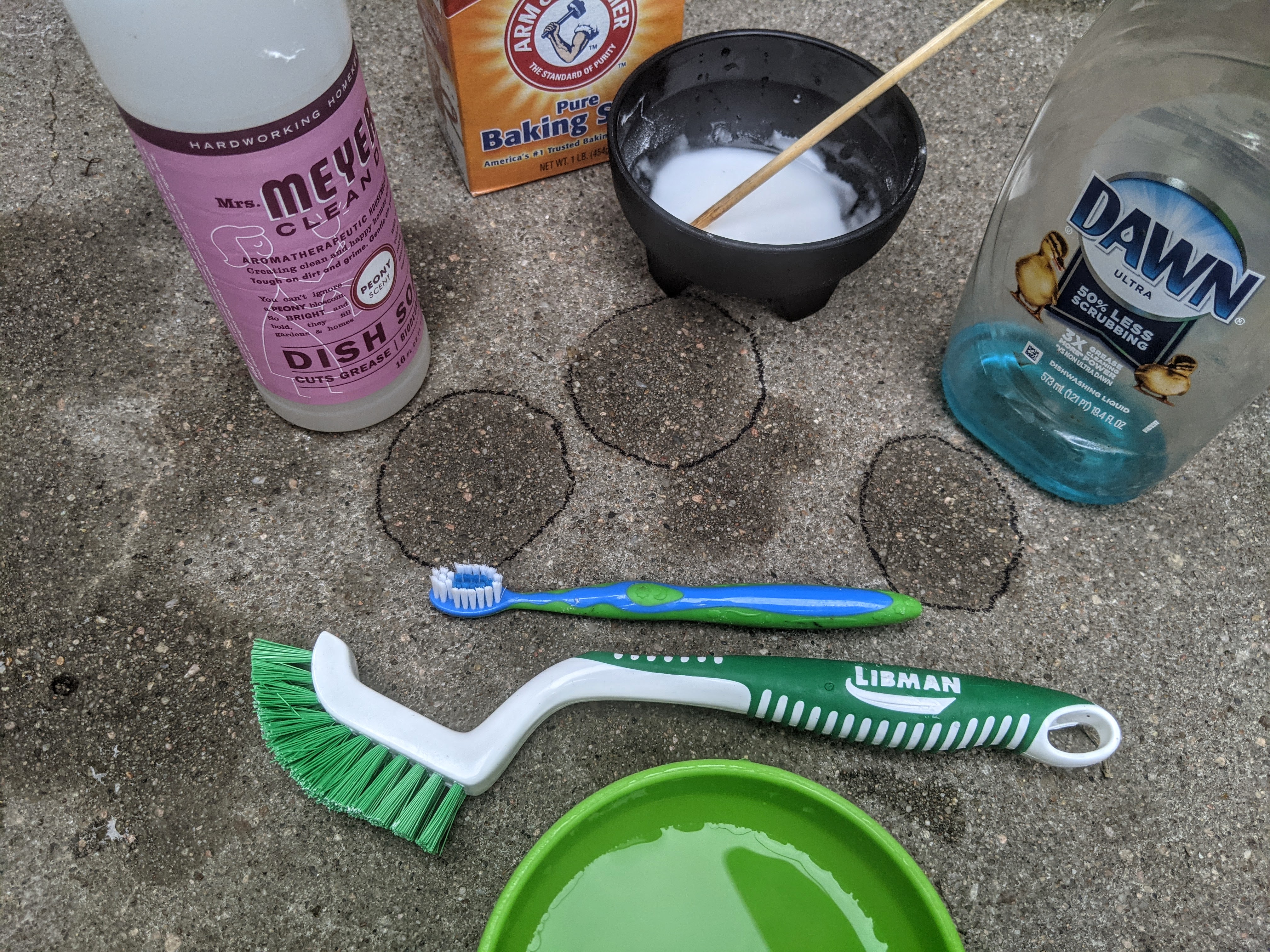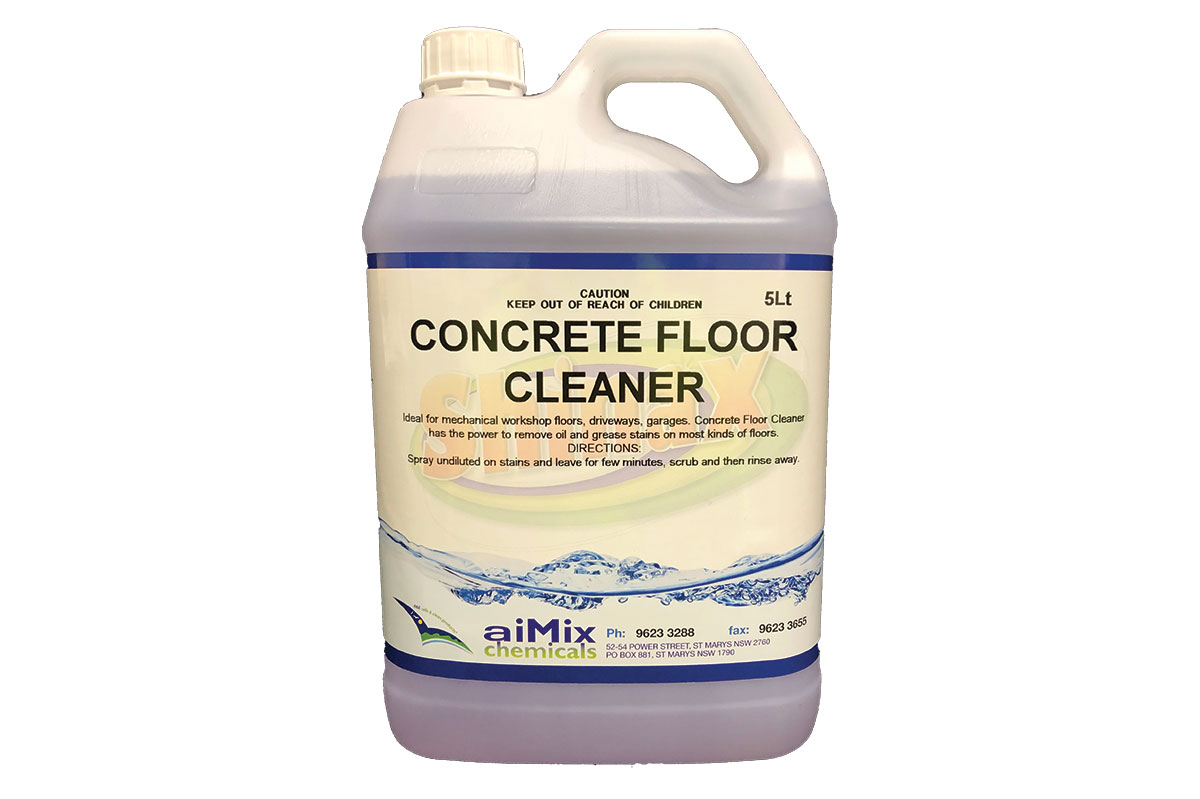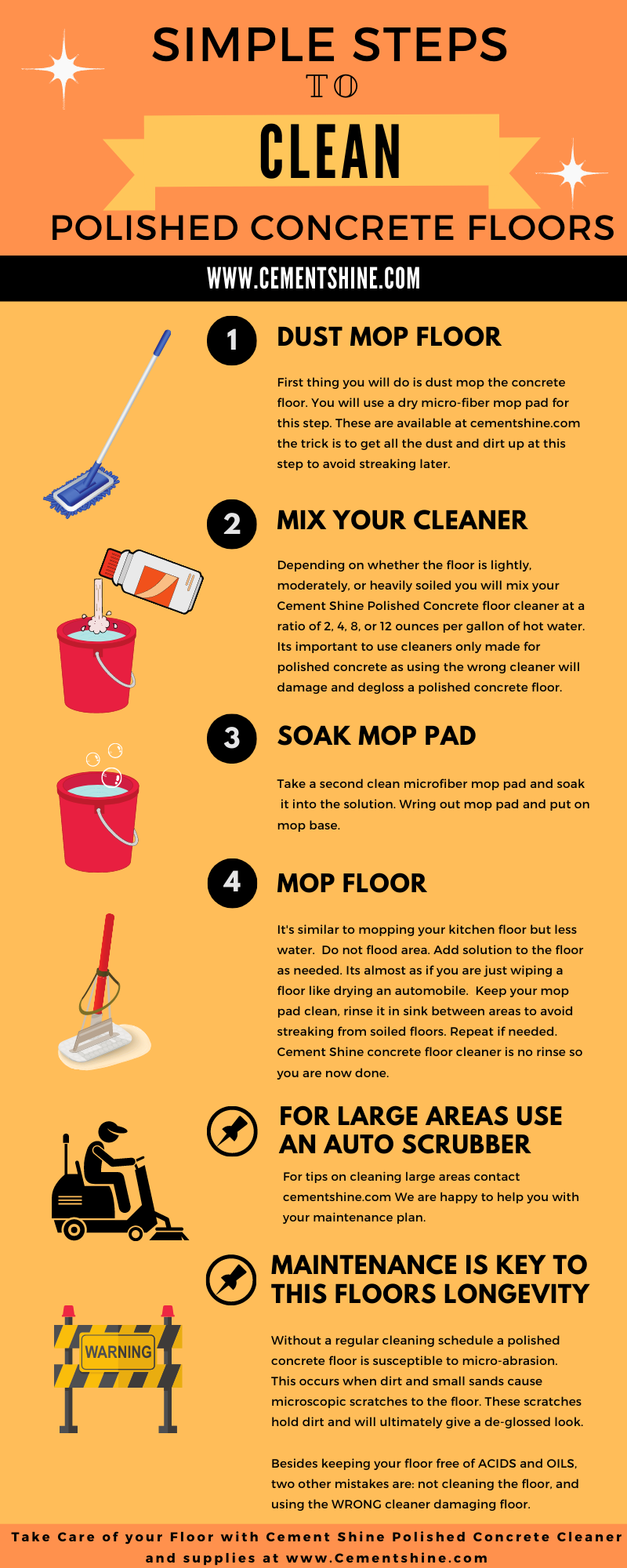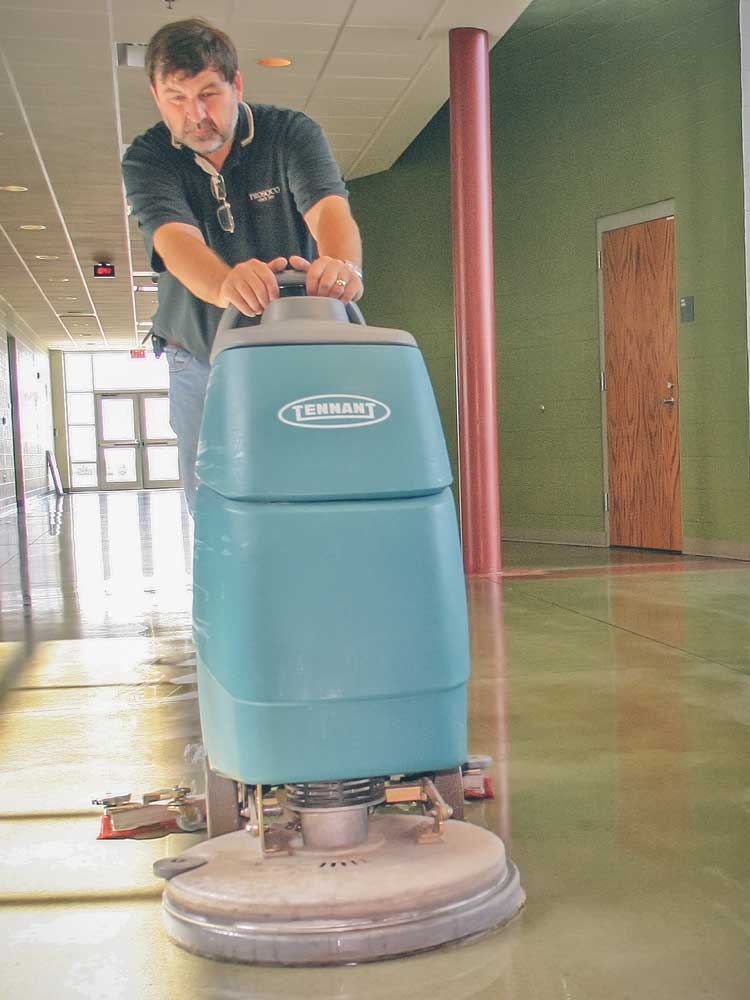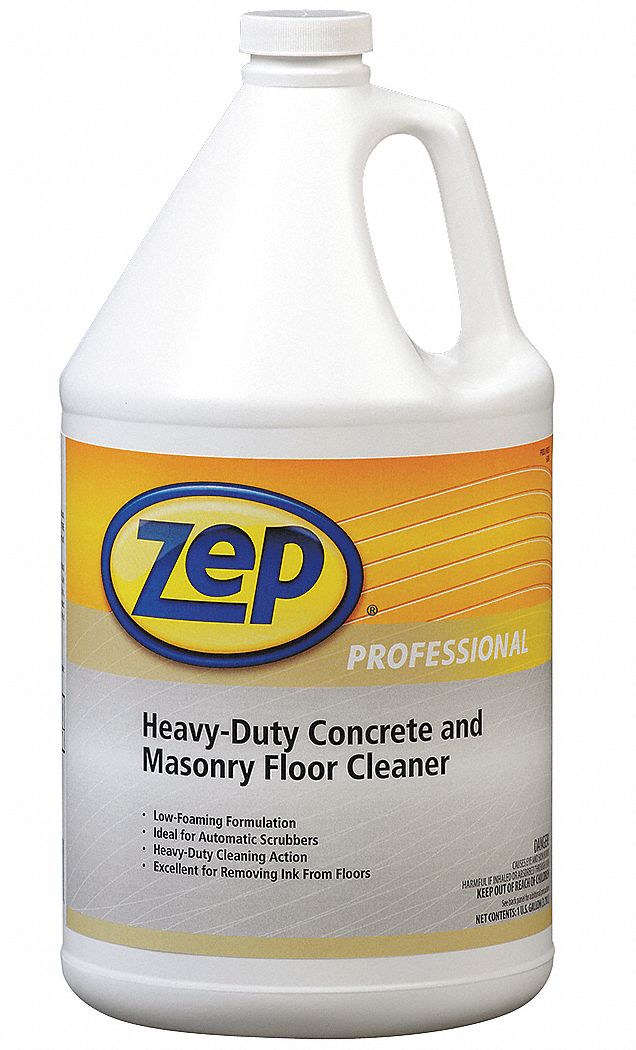Why Concrete Floors Need Special Cleaning Solutions
Concrete floors are known for their durability, strength, and versatility, making them a popular choice for garages, basements, warehouses, and even modern residential spaces. However, maintaining their pristine appearance and functionality requires special care and attention. Unlike other surfaces, concrete is porous and prone to absorbing stains, dirt, oils, and chemicals, making it more challenging to clean without the right solutions. I will explain why concrete floors need specialized cleaning products and what makes them different from other types of flooring.
- Concrete’s Porous Nature Makes It Vulnerable to Stains
Concrete might look solid and impermeable, but in reality, it’s a porous material with tiny holes and capillaries that can trap dirt, oil, and liquids. When these contaminants penetrate the surface, they become much harder to remove than on non-porous surfaces like tile or sealed hardwood. This porous nature means that standard household cleaners often won’t cut it. Instead, you need specially formulated solutions designed to penetrate deep into the concrete, break down the contaminants, and lift them out without damaging the surface. - Regular Cleaners Can Be Too Harsh or Ineffective
Using the wrong type of cleaner can do more harm than good. Concrete floors are sensitive to highly acidic or alkaline substances, which can cause etching or discoloration. For example, vinegar and ammonia—common household cleaners—can damage the surface and make it more prone to future staining. On the flip side, mild detergents may not be strong enough to remove deep-set stains. This is why specialized concrete cleaning solutions are recommended; they’re balanced to be tough on stains but gentle on the floor’s surface. - Grease and Oil Can Permanently Stain Concrete
One of the most common issues with concrete floors, especially in garages, is oil and grease stains. These substances can seep into the porous structure of concrete and create unsightly marks that are almost impossible to remove with regular cleaners. Concrete-specific degreasers and emulsifiers are specially designed to break down these oily residues, making it easier to lift the stains out without scrubbing excessively. Using the right cleaner from the start can save you time, and effort, and prevent permanent damage. - Chemical Spills Require Specialized Cleaners
Garages and industrial settings often expose concrete floors to harsh chemicals like brake fluid, antifreeze, and solvents. If not cleaned up properly, these chemicals can degrade the concrete over time, leading to weakening and surface damage. Specialized concrete cleaners are formulated to neutralize these harmful substances without compromising the integrity of the floor. Some even include sealants that add an extra layer of protection, making it easier to clean up future spills. - Indoor and Outdoor Concrete Floors Have Different Needs
Not all concrete floors are created equal. Outdoor concrete, such as driveways or patios, is exposed to elements like rain, dirt, and UV rays, which can cause mold, mildew, and surface degradation. Indoor concrete, on the other hand, may face challenges like food stains, pet messes, or high foot traffic. Because of these differences, choosing a cleaner specifically suited to the type of environment your concrete is in is crucial. Outdoor concrete may require more aggressive cleaners to tackle moss and mildew, while indoor concrete needs gentler solutions that are safe for use in enclosed spaces. - Protecting Sealed and Polished Concrete Surfaces
If your concrete floor has been sealed or polished, it’s even more important to use the right cleaning products. Harsh chemicals can strip away the protective sealant or dull the polished finish, making the surface vulnerable to staining and damage. There are dedicated cleaners for sealed and polished concrete that help maintain the shine and integrity of the sealant while effectively cleaning the floor. Using the right product ensures that your investment in sealing or polishing your concrete lasts for years to come.

Different Types of Concrete Floor Cleaning Solutions and Their Uses
Not all concrete cleaners are created equal. Depending on the type of stain, surface condition, and cleaning requirements, you’ll need to choose the right product for the job. In this section, I’ll break down the various types of concrete floor cleaning solutions and their specific uses. Understanding these differences will help you select the most effective cleaner for your particular needs, ensuring your concrete surfaces stay clean and undamaged.
pH-Neutral Cleaners for Everyday Cleaning
pH-neutral cleaners are the go-to option for regular maintenance and light cleaning of concrete floors. They are gentle, non-corrosive, and safe for use on all types of concrete surfaces, including sealed and polished floors. These cleaners are ideal for removing dust, dirt, and minor spills without affecting the integrity of the floor. Because they’re non-toxic and mild, they’re perfect for indoor concrete surfaces where harsh chemicals aren’t an option. I recommend using a pH-neutral cleaner as your routine cleaner to keep your concrete looking fresh and well-maintained.
Alkaline Cleaners for Grease and Oil Stains
For tougher jobs like grease, oil, or food stains, an alkaline cleaner is your best bet. Alkaline solutions are specifically designed to break down organic materials, making them highly effective for garages, kitchens, and workshops where grease and oil are common. These cleaners penetrate the porous concrete and emulsify the oils, allowing them to be easily rinsed away. However, because they are more potent, they should be used cautiously to avoid etching or damaging delicate concrete surfaces.
Acidic Cleaners for Mineral and Rust Stains
Acidic cleaners are used for removing mineral deposits, rust stains, and efflorescence from concrete surfaces. They work by dissolving the deposits, making them easier to scrub away. However, these cleaners are quite aggressive and can damage the concrete if used improperly. Always follow the manufacturer’s instructions and wear appropriate safety gear when using acidic cleaners. I recommend these only for tough outdoor stains or as a last resort for severe discoloration.
Concrete Degreasers for Heavy Contamination
If your concrete floor is heavily contaminated with oils, chemicals, or other industrial residues, a concrete degreaser might be necessary. Degreasers are highly concentrated and designed to break down complex hydrocarbons, making them perfect for automotive shops, industrial settings, and garages with significant oil spills. They’re also effective for removing old, set-in stains that other cleaners can’t handle. Keep in mind that degreasers can be quite strong, so proper ventilation and protective equipment are a must when using them.
Enzymatic Cleaners for Organic Stains
Enzymatic cleaners use natural enzymes to break down organic stains like food, blood, and pet urine. They’re a great option for people looking for an eco-friendly, non-toxic cleaner that’s safe for indoor use. Enzymatic cleaners work by digesting the organic material, eliminating not only the stain but also any lingering odors. This makes them an excellent choice for basements, living spaces, or anywhere you might have pets or kids.
Mildew and Mold Removers for Outdoor Concrete
Outdoor concrete surfaces often fall victim to mold, mildew, and moss growth, especially in shaded or damp areas. Mildew and mold removers are formulated to kill these spores and prevent regrowth. Look for cleaners that are specifically designed for concrete and contain biocides that target mold and mildew. These products usually require a bit of scrubbing but can leave your concrete looking fresh and clean. Be sure to rinse the surface thoroughly after application to remove any chemical residues.
DIY vs. Commercial Concrete Cleaners: Which One Should You Choose?
When it comes to cleaning concrete floors, you often have two primary options: making a DIY cleaner using household ingredients or purchasing a commercial concrete cleaner. Both have their pros and cons, and choosing the right one depends on the type of mess you’re dealing with, your budget, and your preferences. I will break down the benefits and drawbacks of each type, along with tips on when to use them to get the best results for your concrete floors.
The Benefits of DIY Concrete Cleaners
DIY concrete cleaners are a popular choice for those who prefer natural or budget-friendly solutions. With just a few simple ingredients like baking soda, vinegar, dish soap, or hydrogen peroxide, you can create effective cleaning solutions for mild stains and general upkeep. One of the biggest advantages of DIY cleaners is that they’re typically non-toxic and safe for use in enclosed spaces, making them ideal for indoor concrete floors. They’re also easy to customize depending on your specific needs—whether you’re dealing with pet stains or grease spills.
Drawbacks of DIY Cleaners
However, DIY concrete cleaners aren’t always powerful enough for tougher stains or heavily soiled surfaces. For example, a mixture of vinegar and baking soda might work well for light cleaning, but it’s unlikely to remove deep-set oil stains or chemical spills. Using the wrong combination of household ingredients can sometimes worsen the situation. Acidic cleaners like vinegar can etch concrete surfaces, leaving them rough and more susceptible to future staining. This is why DIY cleaners are best reserved for routine cleaning and minor spills rather than heavy-duty stain removal.
Advantages of Commercial Concrete Cleaners
Commercial concrete cleaners are specifically formulated to tackle a range of stains and contaminants that DIY solutions simply can’t handle. They’re designed to penetrate deep into the porous surface of concrete, break down tough stains, and lift them out without damaging the floor. With options ranging from pH-neutral cleaners for maintenance to powerful degreasers and acid-based solutions for rust and mineral deposits, commercial products provide a targeted approach for every cleaning need. Plus, they’re often easier and quicker to use—just follow the instructions on the label.
The Cost Factor: DIY vs. Commercial
Cost is a significant factor when choosing between DIY and commercial cleaners. DIY solutions are generally much cheaper, as they use ingredients you likely already have at home. Commercial cleaners, on the other hand, can be more expensive, especially if you’re buying specialized products for specific stains. However, the added expense can be worth it if you’re dealing with a particularly stubborn stain or if you want a product that will get the job done right the first time. In the long run, using the right cleaner from the start can save you time and money by avoiding repeat cleanings or damage to your concrete.
Safety Considerations
Safety is another important aspect to consider. DIY cleaners are typically less harsh and more environmentally friendly, making them a safer option for homes with children or pets. On the flip side, some commercial concrete cleaners can contain strong chemicals that require proper ventilation and protective gear. If you’re using a commercial product, always read the label carefully, follow the safety instructions, and ensure the area is well-ventilated. If safety is a top concern, you might prefer to stick with DIY solutions for general maintenance and only use commercial products for heavy-duty jobs.
Which One Should You Choose?
So, should you go with a DIY or commercial cleaner? It ultimately depends on the type of stain, the condition of your concrete, and your preferences. If you’re looking for a cost-effective and eco-friendly way to maintain indoor concrete, DIY cleaners are a solid choice. But if you’re dealing with deep-set stains, oil spills, or industrial contaminants, commercial cleaners are the way to go. In many cases, a combination of both—using DIY solutions for routine cleaning and commercial products for tougher jobs—can be the most effective approach.
Step-by-Step Guide to Preparing and Using Concrete Floor Cleaning Solutions
Whether you’re using a DIY or commercial cleaner, knowing how to prepare and apply the solution is essential for achieving the best results. Concrete cleaning requires more than just pouring a solution on the floor and scrubbing. Proper preparation and application techniques can make all the difference in ensuring that your concrete floor ends up spotless and undamaged. Let me guide you through the steps you need to take to get your concrete cleaning solution ready and how to apply it for maximum effectiveness.
Step 1: Gather the Necessary Tools and Materials
Before you start, make sure you have everything you need. For most concrete cleaning jobs, you’ll need a stiff-bristle brush or broom, a mop, a bucket, protective gloves, and safety glasses. If you’re using a commercial cleaner, read the label to see if any additional tools are recommended, such as a scrubbing machine for large areas. For DIY solutions, have your ingredients—like baking soda, dish soap, or hydrogen peroxide—on hand. Gathering all the tools in advance will ensure a smooth and efficient cleaning process.
Step 2: Clear the Area and Remove Surface Debris
Start by clearing the concrete floor of any furniture, tools, or other obstacles. Sweep or vacuum the surface to remove loose dirt, dust, and debris. This step is crucial because any grit left on the floor can scratch the surface during scrubbing, and loose dirt will reduce the effectiveness of your cleaning solution. For outdoor concrete, use a leaf blower to clear away leaves and larger debris. Taking the time to properly prepare the area will make the actual cleaning process much more effective.
Step 3: Mix the Cleaning Solution
If you’re using a commercial cleaner, follow the manufacturer’s instructions for mixing. Many commercial products need to be diluted with water, so pay attention to the recommended ratio. For DIY solutions, mix your ingredients according to the recipe. For example, a basic DIY concrete cleaner could include a cup of baking soda, a few tablespoons of dish soap, and warm water. For tougher stains, you might add hydrogen peroxide or a splash of ammonia. Make sure the solution is well-mixed to ensure even cleaning across the surface.
Step 4: Apply the Solution Evenly Across the Surface
Pour or spray the cleaning solution evenly over the concrete floor. For large areas, work in sections to ensure that the cleaner doesn’t dry before you have a chance to scrub it in. Use a mop, sponge, or sprayer depending on the size of the area and the type of cleaner you’re using. Make sure to saturate the entire surface, paying extra attention to areas with visible stains or heavy dirt buildup. If you’re using a commercial cleaner, let it sit for the recommended time to allow the chemicals to penetrate the surface.
Step 5: Scrub the Surface Thoroughly
Using a stiff-bristle brush, scrub the floor in a circular motion to work the cleaner into the pores of the concrete. For stubborn stains, apply extra pressure and focus on scrubbing in different directions. If you’re working in a large area, consider using a floor scrubber to save time and energy. Scrubbing is essential for lifting dirt and stains that have settled into the surface. Be patient and thorough—rushing through this step can leave behind residual stains.
Step 6: Rinse and Dry the Floor
After scrubbing, it’s time to rinse the floor thoroughly. Use a hose for outdoor areas or a bucket of clean water and a mop for indoor surfaces. Rinse until all traces of the cleaner are removed, as leftover residue can make the floor slippery or attract more dirt. Once rinsed, let the floor dry completely before walking on it or placing items back in the area. Proper drying ensures that no water spots or streaks are left behind, leaving your concrete floor looking clean and fresh.
Safety Tips When Handling Concrete Floor Cleaning Solutions
Concrete floor cleaning solutions can range from mild, pH-neutral formulas to highly corrosive and powerful chemicals, depending on their intended use. Regardless of whether you’re using a DIY or commercial cleaner, prioritizing safety is crucial to protect yourself, your surfaces, and anyone around you. Below are essential safety tips to keep in mind when handling concrete cleaning solutions, including proper protective gear, safe application methods, and how to store these products safely.
Wear Appropriate Personal Protective Equipment (PPE)
When working with concrete cleaners—especially stronger, commercial-grade solutions—always wear the proper safety gear. This typically includes rubber gloves, safety glasses or goggles, and sturdy footwear to protect your skin and eyes from chemical splashes. Some cleaners, like acid-based solutions or heavy-duty degreasers, can emit fumes that irritate the respiratory system, so it’s also advisable to wear a face mask or respirator if ventilation is inadequate. Even for mild DIY solutions, gloves are recommended, as prolonged contact with cleaners can dry out or irritate the skin.
Ensure Proper Ventilation
Many concrete cleaning solutions, particularly those used in garages or basements, can emit strong fumes that may pose health risks if inhaled over long periods. To minimize exposure, always ensure that the area is well-ventilated. Open doors and windows if you’re working indoors, and consider using a fan to keep air circulating. If you’re cleaning in a confined space or using particularly strong chemicals, wearing a respirator is a good safety measure to protect your lungs. Never work with toxic cleaners in a closed area without proper airflow, as fumes can quickly accumulate and cause dizziness or respiratory distress.
Follow Manufacturer Instructions Precisely
If you’re using a commercial concrete cleaner, take the time to read the product label thoroughly before starting. Each product is formulated differently and may have specific instructions for dilution, application, and rinsing. Overusing a concentrated cleaner or applying it incorrectly can damage your concrete and pose safety hazards. For instance, mixing certain chemicals—like acids and bleach—can create toxic gases. Always stick to the manufacturer’s guidelines, and if you have any doubts, consult their customer support or look for instructional videos that demonstrate safe usage.
Test the Solution in a Small, Inconspicuous Area First
Before applying any cleaning solution—whether DIY or commercial—test it in a small, hidden area of the concrete floor. This is especially important if your concrete is sealed, polished, or painted, as harsh chemicals can cause discoloration or etching. Apply a small amount of the solution and let it sit for the recommended time, then rinse and inspect the area. If there are no adverse effects, you can proceed with confidence. Skipping this step can result in unwanted damage that might be difficult or expensive to fix.
Use the Right Tools and Techniques
The tools you use can have a big impact on the effectiveness and safety of your cleaning process. For example, using a wire brush on polished or sealed concrete can cause scratches, while high-pressure washers can erode the surface if used improperly. Always choose tools that are appropriate for the surface you’re cleaning. For most concrete floors, a stiff-bristle brush, mop, and sponge will suffice. Avoid using metal tools or overly abrasive materials unless you’re working with unsealed, industrial-grade concrete. Using the right tools helps prevent damage and reduces the risk of accidents.
Safe Storage and Disposal of Cleaning Products
Proper storage and disposal of cleaning solutions are just as important as their application. Store all concrete cleaners in a cool, dry place out of reach of children and pets. Keep them in their original containers with labels intact to avoid confusion or accidental misuse. Never transfer these chemicals into unmarked bottles, as this can lead to dangerous mistakes. When it comes to disposal, never pour leftover cleaner down the drain or onto the ground, as many of these products can harm the environment. Check the label for specific disposal instructions or contact your local waste management facility for guidance on safe disposal methods.
How to Remove Stubborn Stains from Concrete Floors: Best Solutions and Techniques
Concrete floors are notorious for attracting and retaining stubborn stains, from oil spills in garages to rust and mildew on patios. These stains can be difficult to remove, but with the right solutions and techniques, you can restore your concrete surfaces to their original condition. Let me walk you through the best methods for tackling some of the most common and challenging stains on concrete, including oil, rust, paint, and mold.
Removing Oil and Grease Stains
Oil and grease stains are some of the most common issues for concrete floors, especially in garages and driveways. To tackle these stains, start by blotting up as much of the oil as possible with paper towels or absorbent materials like cat litter. Once the excess oil is removed, apply a concrete degreaser or an alkaline cleaner to the affected area. Scrub the stain with a stiff-bristle brush in a circular motion, working the cleaner into the pores of the concrete. Let it sit for the recommended time before rinsing with warm water. For deep-set stains, you may need to repeat the process or use a poultice made of baking soda and water to draw out the oil.
Treating Rust Stains
Rust stains can occur on concrete due to metal tools, furniture, or even hard water deposits. Acidic cleaners, such as those containing oxalic acid or hydrochloric acid, are your best bet for removing these stubborn marks. Apply the cleaner carefully, using gloves and safety goggles, and let it sit for a few minutes before scrubbing with a nylon brush. Rinse thoroughly to remove any residue, as leftover acid can continue to etch the concrete. For minor rust stains, a mixture of lemon juice and baking soda can also be effective and is less harsh than commercial acids.
Eliminating Mold and Mildew
Mold and mildew are common problems for outdoor concrete surfaces, particularly in shaded or damp areas. To remove these stains, start by scrubbing the surface with a mixture of water and dish soap. If the mold persists, switch to a cleaner specifically designed for mold and mildew removal, such as one containing bleach or hydrogen peroxide. Apply the solution to the affected area and let it sit for at least 15 minutes before scrubbing again. Be sure to rinse thoroughly and allow the area to dry completely to prevent the mold from returning.
Dealing with Paint Spills and Graffiti
Paint and graffiti stains can be particularly challenging to remove from concrete surfaces. For small paint spills, use a paint stripper or solvent specifically designed for concrete. Apply the stripper, let it sit according to the manufacturer’s instructions, and then scrub the area with a stiff brush. For graffiti, try using a graffiti remover or a strong solvent, followed by pressure washing if necessary. If the stain is stubborn, you might need to use a poultice or sandblasting for complete removal, though these methods should be used cautiously to avoid damaging the concrete.
Handling Efflorescence and Mineral Deposits
Efflorescence is the white, powdery residue that sometimes appears on concrete surfaces due to moisture migration. To remove it, start by scrubbing the area with a dry brush to loosen the deposits. Then, use an acidic cleaner—such as vinegar or a commercial efflorescence remover—to dissolve the remaining residue. Apply the cleaner, scrub gently, and rinse thoroughly. For tough deposits, a repeat application may be necessary. Be cautious with acidic cleaners, as prolonged exposure can damage the concrete surface.
Using Poultices for Deep Stains
For deeply embedded stains that won’t budge with regular scrubbing, a poultice can be highly effective. To make a poultice, mix an absorbent material like baking soda or diatomaceous earth with a strong cleaning agent (such as a degreaser or solvent) to form a thick paste. Apply the paste to the stain, cover it with plastic wrap, and let it sit for several hours or overnight. The poultice will draw the stain out of the concrete. Once it’s dry, scrape off the paste and rinse the area. This technique is particularly useful for oil, ink, or chemical stains that have penetrated deeply into the concrete.
Long-Term Maintenance: Keeping Your Concrete Floors Clean and Shiny
Proper maintenance is key to preserving the appearance and durability of your concrete floors. Concrete, by nature, is a porous material that can accumulate dirt, stains, and even cracks over time if not cared for properly. Whether you’ve just finished a deep cleaning or want to maintain a newly polished surface, implementing a long-term maintenance routine will help your concrete floors stay looking their best. I will go over practical tips and strategies to keep your concrete floors clean, shiny, and protected from future damage.
Establish a Regular Cleaning Routine
The best way to keep your concrete floors looking new is by establishing a consistent cleaning routine. This involves sweeping or vacuuming the surface regularly to remove dirt, dust, and debris that can gradually dull the finish and scratch the surface. For indoor concrete floors, consider using a soft-bristle broom or a microfiber mop, as these tools will effectively capture small particles without causing scratches. For outdoor concrete, a leaf blower or garden hose can be used to remove dirt and leaves. Regular sweeping not only keeps the floor clean but also prevents grit from being ground into the surface, which can cause permanent damage.
Use Appropriate Cleaning Products
Choosing the right cleaning products is essential for long-term maintenance. For everyday cleaning, use a pH-neutral cleaner specifically designed for concrete, as acidic or alkaline solutions can damage the finish and cause discoloration over time. Avoid harsh chemicals like ammonia, bleach, or vinegar, which can weaken the concrete and strip away any protective sealants. If your concrete floor is sealed or polished, opt for a cleaner that’s safe for use on these finishes to prevent dulling or etching. Investing in high-quality cleaning products will pay off in the form of a floor that maintains its shine and integrity for years.
Seal and Reseal the Concrete Regularly
Sealing your concrete floors is one of the most effective ways to protect them from stains, moisture, and wear. A good sealer creates a protective barrier on the surface, making it easier to clean up spills and preventing dirt and grime from penetrating the concrete. For high-traffic areas like garages and driveways, consider using a high-performance sealer such as a polyurethane or epoxy. Resealing should be done every 2-3 years, depending on the amount of wear and tear your floor experiences. Before resealing, make sure the surface is thoroughly cleaned and free of any dirt or grease, as applying sealer over debris can trap it in the finish.
Address Spills and Stains Promptly
Even with a protective seal, it’s important to clean up spills and stains as soon as possible. Concrete is a porous material, and liquids can seep into the surface quickly if left unattended. Oil, grease, chemicals, and even water can leave stains that are difficult to remove if not addressed immediately. Use a mild cleaner and a soft cloth to blot up spills, and for tougher stains, consider using a degreaser or specialized concrete cleaner. Avoid scrubbing too aggressively, as this can spread the stain or damage the surface. Promptly addressing spills not only prevents staining but also helps maintain the overall appearance of your concrete floor.
Implement Preventive Measures to Reduce Wear and Tear
Preventive measures can go a long way in reducing the need for frequent cleaning and repairs. For indoor concrete floors, consider using rugs or mats in high-traffic areas, such as entryways or kitchen floors, to capture dirt and moisture before it reaches the concrete. In garages or driveways, place mats under vehicles to catch oil drips and spills. For outdoor concrete, keep nearby trees and plants trimmed to reduce leaf litter and organic debris. Regularly inspect your concrete floors for small cracks or chips and repair them promptly to prevent them from growing into larger issues.
Polish or Buff the Surface for a High-Shine Finish
If you want your concrete floor to have a shiny, polished look, consider buffing or polishing the surface regularly. Polishing can enhance the natural beauty of concrete and create a glossy finish that’s easy to maintain. Use a concrete polishing machine or a buffing pad to restore shine to dull areas, and apply a polishing compound if necessary. Polished concrete not only looks great but is also more resistant to stains and wear. If your concrete has a matte finish, you can still benefit from periodic buffing to remove surface imperfections and maintain a smooth, even texture.
Avoid Using Abrasive Tools and Harsh Cleaning Methods
To keep your concrete floors looking their best, it’s important to use the right tools and cleaning techniques. Avoid using metal brushes, scouring pads, or high-pressure washers on polished or sealed concrete, as these can cause scratches and degrade the finish. Similarly, avoid harsh scrubbing or the use of abrasive cleaning powders, which can create unsightly marks on the surface. Instead, opt for soft-bristle brushes and gentle, non-abrasive cleaning solutions. If you need to remove tough stains, use a poultice or a specialized stain remover that’s safe for your type of concrete.
Consider Applying a Decorative Finish or Overlay
If you want to take your concrete maintenance to the next level, consider applying a decorative finish or overlay. Options like concrete stains, dyes, or overlays can give your floor a unique appearance and add an extra layer of protection. Decorative finishes are particularly useful for outdoor patios, pool decks, or indoor areas where aesthetics are a priority. Choose a finish that complements your space and is compatible with the existing concrete. Decorative overlays not only enhance the appearance of your floor but also provide a durable, easy-to-maintain surface that resists stains and damage.
Schedule Deep Cleaning Sessions Annually
While regular sweeping and mopping are essential, it’s also a good idea to schedule deep cleaning sessions at least once a year. This involves using a more intensive cleaning method, such as power washing (for unsealed concrete), steam cleaning, or using a strong degreaser to remove built-up grime and restore the floor’s original appearance. Deep cleaning can remove dirt and stains that have accumulated over time, ensuring that your concrete floor remains in top condition. After deep cleaning, consider resealing the floor to provide continued protection and maintain its appearance.
Monitor and Maintain the Floor’s Condition
Finally, regular monitoring and maintenance are key to keeping your concrete floors looking new. Inspect the surface for any signs of wear, discoloration, or cracking, and address issues as soon as they arise. Small problems like hairline cracks or minor stains can be easy to fix when caught early but can lead to significant damage if ignored. By staying on top of maintenance and being proactive about repairs, you can extend the lifespan of your concrete floor and keep it looking clean and shiny for years to come.
Floor Scrubber Cleaning Solution
How to Clean Concrete Floors
All Purpose Cleaner and Floor Cleaner Concentrate, Multi-Surface Cleaner for Home Office and Kitchen Floor, Concentrated Multipurpose Cleaner, 1
Concrete/Masonry Floor Cleaner, 1 gal, Jug
Related Posts:
